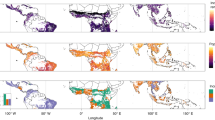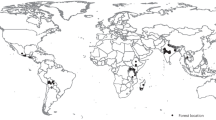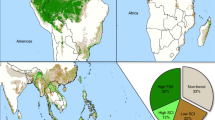Abstract
The restoration of tree cover has been placed at the top of international policy agendas, yet often, the ‘type’ of restored forests can be widely different, with consequences for biodiversity and livelihoods. Here we used a map of forest management types to assess the extent of managed forests in recent tree cover gains globally. We call on policymakers to differentiate forest management as a distinct element of reforestation targets.
This is a preview of subscription content, access via your institution
Access options
Access Nature and 54 other Nature Portfolio journals
Get Nature+, our best-value online-access subscription
$29.99 / 30 days
cancel any time
Subscribe to this journal
Receive 12 digital issues and online access to articles
$119.00 per year
only $9.92 per issue
Buy this article
- Purchase on Springer Link
- Instant access to full article PDF
Prices may be subject to local taxes which are calculated during checkout


Similar content being viewed by others
Data availability
All land-cover data are publicly available through Google Earth Engine (Code availability). The global FML has been released as part of a previous study10. The validation data created as part of this work are made available as a separate data file on a GitHub repository (https://github.com/Martin-Jung/FML_ForestGain) with the methods described in Supplementary Information. Source data are provided with this paper.
Code availability
The Google Earth Engine script used to extract the information has been made available in Supplementary Information. All other scripts are made available on a GitHub repository (https://github.com/Martin-Jung/FML_ForestGain).
Change history
01 September 2023
A Correction to this paper has been published: https://doi.org/10.1038/s41893-023-01227-0
References
Strassburg, B. B. N. et al. Global priority areas for ecosystem restoration. Nature 586, 724–729 (2020).
Bastin, J.-F. et al. The global tree restoration potential. Science 365, 76–79 (2019).
Verdone, M. & Seidl, A. Time, space, place, and the Bonn Challenge global forest restoration target. Restor. Ecol. 25, 903–911 (2017).
Lewis, S. L., Wheeler, C. E., Mitchard, E. T. A. & Koch, A. Restoring natural forests is the best way to remove atmospheric carbon. Nature 568, 25–28 (2019).
Martin, M. P. et al. People plant trees for utility more often than for biodiversity or carbon. Biol. Conserv. 261, 109224 (2021).
Bremer, L. L. & Farley, K. A. Does plantation forestry restore biodiversity or create green deserts? A synthesis of the effects of land-use transitions on plant species richness. Biodivers. Conserv. 19, 3893–3915 (2010).
Newbold, T. et al. Global effects of land use on local terrestrial biodiversity. Nature 520, 45–50 (2015).
Uriarte, M. & Chazdon, R. L. Incorporating natural regeneration in forest landscape restoration in tropical regions: synthesis and key research gaps. Biotropica 48, 915–924 (2016).
McEwan, A., Marchi, E., Spinelli, R. & Brink, M. Past, present and future of industrial plantation forestry and implication on future timber harvesting technology. J. For. Res. 31, 339–351 (2020).
Lesiv, M. et al. Global forest management data for 2015 at a 100 m resolution. Sci. Data 9, 199 (2022).
Hansen, M. C. et al. High-resolution global maps of 21st-century forest cover change. Science 342, 850–853 (2013).
Jung, M. et al. Areas of global importance for conserving terrestrial biodiversity, carbon and water. Nat. Ecol. Evol. 5, 1499–1509 (2021).
Hua, F. et al. Tree plantations displacing native forests: the nature and drivers of apparent forest recovery on former croplands in southwestern China from 2000 to 2015. Biol. Conserv. 222, 113–124 (2018).
Fagan, M. E., Reid, J. L., Holland, M. B., Drew, J. G. & Zahawi, R. A. How feasible are global forest restoration commitments? Conserv. Lett. 13, e12700 (2020).
Buchhorn, M. et al. Copernicus Global Land Cover layers—collection 2. Remote Sens. 12, 1044 (2020).
Malkamäki, A. et al. A systematic review of the socio-economic impacts of large-scale tree plantations, worldwide. Glob. Environ. Change 53, 90–103 (2018).
Global Forest Resources Assessment 2020: Main Report (FAO, 2020); https://doi.org/10.4060/ca9825en
Sexton, J. O. et al. Conservation policy and the measurement of forests. Nat. Clim. Change 6, 192–196 (2016).
ESA CCI Product User Guide Ver. 2 (ESA CCI, 2017).
Sulla-Menashe, D., Gray, J. M., Abercrombie, S. P. & Friedl, M. A. Hierarchical mapping of annual global land cover 2001 to present: The MODIS Collection 6 Land Cover product. Remote Sens. Environ. 222, 183–194 (2019).
Gorelick, N. et al. Google Earth Engine: planetary-scale geospatial analysis for everyone. Remote Sens. Environ. 202, 18–27 (2017).
Acknowledgements
We acknowledge funding from Norway’s International Climate and Forest Initiative (NICFI). We thank M. Dürauer, I. Georgieva and M. Shchepashchenko for their assistance through Geo-Wiki.
Author information
Authors and Affiliations
Contributions
M.J. conceived the idea, led the analysis and drafted the paper. M.L. contributed data and edited the paper. E.W.-T., D.S., L.S. and S.F. conceived the idea and contributed to the drafting of the paper.
Corresponding author
Ethics declarations
Competing interests
The authors declare no competing interests.
Peer review
Peer review information
Nature Sustainability thanks Matthew Fagan, Paula Meli and the other, anonymous, reviewer(s) for their contribution to the peer review of this work.
Additional information
Publisher’s note Springer Nature remains neutral with regard to jurisdictional claims in published maps and institutional affiliations.
Supplementary information
Supplementary Information
Supplementary Methods, Figures and Tables.
Source data
Source Data Fig. 1a
Source data for the timeline data in Fig. 1b.
Source Data Fig. 1b
Source data for the proportion data in Fig. 1c.
Source Data Fig. 2a
Source data for Fig. 2a.
Source Data Fig. 2b
Source data for Fig. 2b.
Rights and permissions
Springer Nature or its licensor (e.g. a society or other partner) holds exclusive rights to this article under a publishing agreement with the author(s) or other rightsholder(s); author self-archiving of the accepted manuscript version of this article is solely governed by the terms of such publishing agreement and applicable law.
About this article
Cite this article
Jung, M., Lesiv, M., Warren-Thomas, E. et al. The importance of capturing management in forest restoration targets. Nat Sustain 6, 1321–1325 (2023). https://doi.org/10.1038/s41893-023-01192-8
Received:
Accepted:
Published:
Issue Date:
DOI: https://doi.org/10.1038/s41893-023-01192-8



